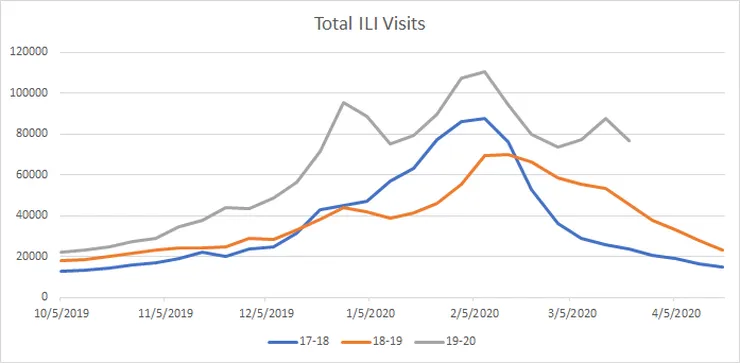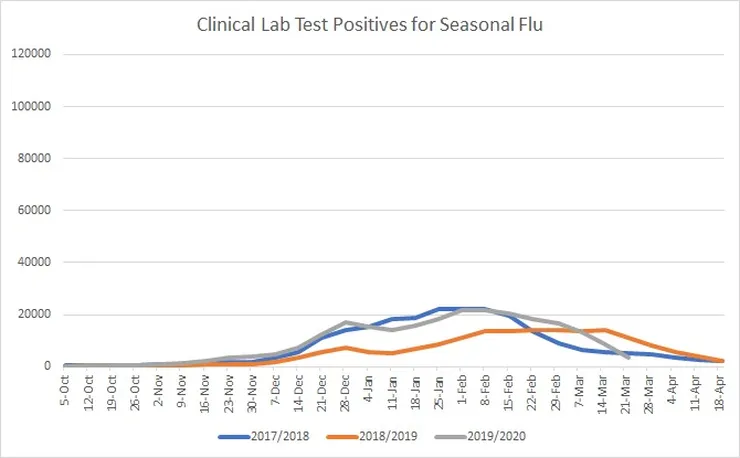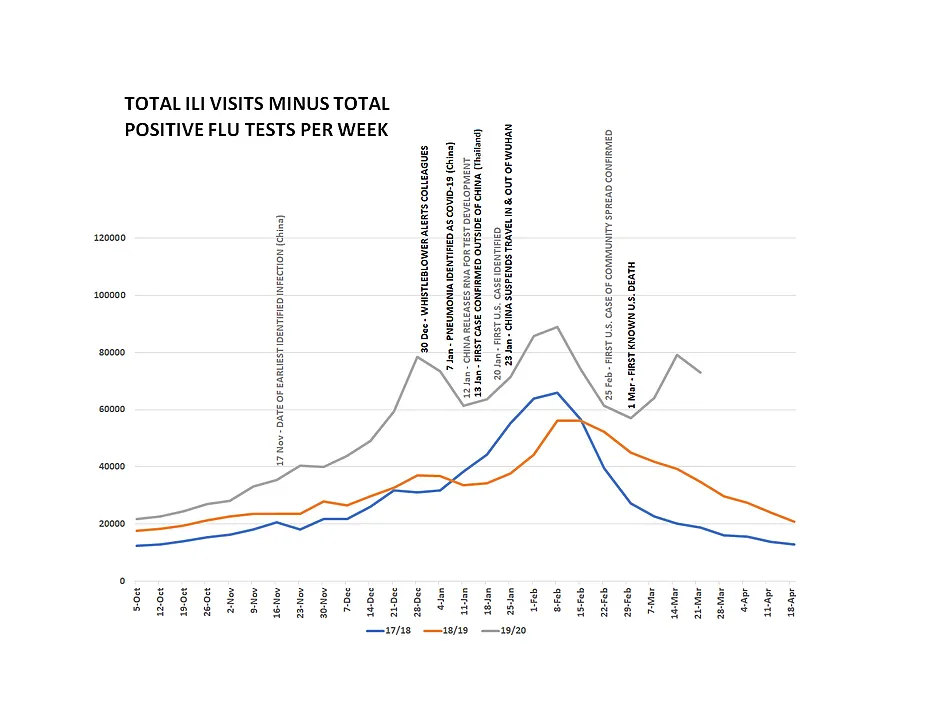It seems the coronavirus infection of the US population could have started as early as December, possibly even November. There are two source for this theory. One is from the LA Times which spoke with Dr. Jeff Smith, a physician who is the chief executive of Santa Clara County government. The other is from from an independent investigator who gathered data for influenza-like illnesses that were much higher than seasonal norms.
The LA Times story is New signs suggest coronavirus was in California far earlier than anyone knew, which goes on to say:
“The virus was freewheeling in our community and probably has been here for quite some time,” Dr. Jeff Smith, a physician who is the chief executive of Santa Clara County government, told county leaders in a recent briefing.
How long? A study out of Stanford suggests a dramatic viral surge in February.
But Smith on Friday said data collected by the federal Centers for Disease Control and Prevention, local health departments and others suggest it was “a lot longer than we first believed” — most likely since “back in December.”
“This wasn’t recognized because we were having a severe flu season,” Smith said in an interview. “Symptoms are very much like the flu. If you got a mild case of COVID, you didn’t really notice. You didn’t even go to the doctor. The doctor maybe didn’t even do it because they presumed it was the flu.”
This indicates that the actual number of infected is much larger than is being reported. This would drastically drive down the death rates for those infected with COVID-19.
The other article speaks of a similar conclusion about the increase in severity of the flu season that started back in November. AJ Kay originally published the post on the website Medium.com, who subsequently censored her and deleted it from their site. You can find the article on another site with the title New signs suggest coronavirus was in California far earlier than anyone knew. It was co-authored with Thomas P. Seager, PhD.
Many of those calls, doctor visits, and hospitalizations categorized as “flu-like-illness” may have been due to the novel coronavirus for which the UK did not know to be looking and was not able to test and, ergo, assumed that it was “just the flu”. Especially given the exaggerated degree of severity noted at the end.
Because many of COVID’s symptoms are so similar to the flu, a good place to look for indications of COVID’s early presence in the US is in the CDC Flu Surveillance data. If COVID were widely disseminated in November or December, it’s presence would have likely caused an increase in doctor visits shortly after it began its rapid spread.
Here is a graph of weekly physician-reported visits for Influenza-like-illness (ILI) reported to the CDC for 2019–2020 year-to-date and for the last two flu seasons.

Source
Flu-like illness reports exceeded 30,000 per week in early November 2019, and were soon running almost double the rate of previous recent years.
Nearly twice as many ILI visits were reported during the beginning of the 2019–2020 flu season than were reported in either of the two previous years. By December 2019, there were over 80,000 US patients seeking treatment for flu-like symptoms — long before Chinese authorities reported COVID to global health organizations on 31 Dec 2019.
Many of the Americans reporting flu symptoms had one of the six strains of ordinary, seasonal flu routinely monitored by the CDC. However, those cases do not account for either the timing nor the dramatic increase in ILI this year. The graph below shows how the volume of positive seasonal flu tests per week in 2019–20 compares to previous years.

Source
The number of positive seasonal flu tests is relatively small in comparison to total ILI visits. That is, most cases of ILI visits in any given year remain unexplained by the flu. However, this year was unique in both the sheer volume of unexplained ILI visits and the early date that the surge of visits began.
...
The unidentifiable, mysterious flu-like illness curve looks like this:

Source
A simple explanation for the dramatic increase in ILI visits in November-December 2019 is an earlier-than-presumed seeding of COVID in the U.S. Taking into account CDC Flu surveillance data, the early-January seed date utilized by the Imperial Study seems unlikely.
Given the above information, there was an ILI illness spreading since November. You can see the total ILI hospital visits minus the influenza positive tests, shows there is a large amount of ILI visits remaining, which includes influenza cases that haven't been tested, and possibly includes coronavirus illnesses already spreading.
It could be that all of this is only influenza illness, that this flu season started off twice as strong as previous seasons. But I think the theory that there was something else in addition to influenza causing this doubling of visits to the hospital, is a sound theory, and indicates that the coronavirus was possibly already in the US. It could have been some other ILI though.
Given we are dealing with coronavirus, and where the virus infections started, it's possible the infections started early in the US. It's also possible the infection in the US started before China. Ft. Detrick lab had two breaches in 2019, resulting the closure of the labs for some time:
The two breaches reported by USAMRIID to the CDC demonstrated a failure of the Army laboratory to "implement and maintain containment procedures sufficient to contain select agents or toxins" that were made by operations in biosafety level 3 and 4 laboratories, according to the report
It's possible, as some have theorized, that the coronavirus infections first came from Ft. Detrick. We may never know. But it would be nice to have the coronavirus in the labs compared to the coronavirus people are infected with to see if they match.
